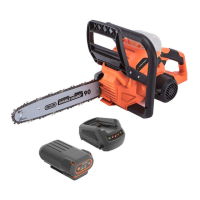23
1. With a basic understanding of kickback , you can reduce or eliminate the element of sud-
den surprise contributes to accidents;
2. Keep a good rm grip on the saw with both hands, the right hand on the rear handle and
the left hand on the front handle, when the tools is running. Use a rm grip with thumbs
and ngers encircling the chain saw handles. A rm grip will help you reduce kickback and
maintain control of the saw. Don't let go;
3. Make sure that the area in which you are cutting is free from obstructions. Do not let the
nose of the guide bar contact a log, branch, or any other obstruction that could be hit while
you are operating the saw;
4. Cut at high speed;
5. Do not overreach or cut above shoulder height;
6. Follow the manufacturer's sharpening and maintenance instructions for the saw chain;
7. Only use replacement bars and chains specied by the manufacturer or the equivalent
8. Use extreme caution when entering a previous cut.
9. Do not attempt plunge cuts if you are not familiar with this cutting technique.
10. Stand to the side of the cutting path of the chainsaw.
11. Cut with a correctly sharpened, properly tensioned chain at all times.
12. Using the pull stroke ,if possible
Pull stroke
As shown in Fig13
This technique involves sawing from top to
bottom with the underside of the saw rail. The
chain saw pushes the product forwards and
away from the user. This way, the front edge of
the product forms a support, which intercepts
forces generated on the log when sawing. With
pull sawing, the user has much more control
over the product and is better able to avoid
kickback This is therefore the preferred sawing
technique.
Fig 13
KNOWLEDGE OF KICKBACK

